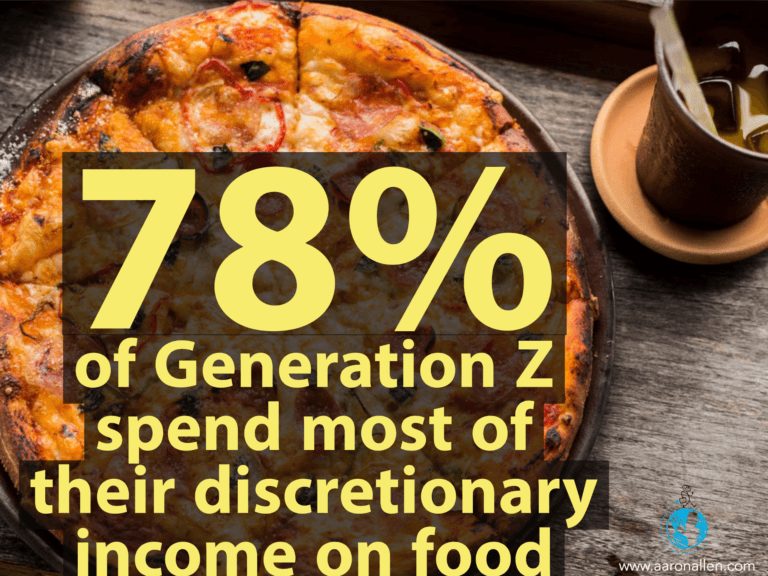Generation Z is expected to reach 2.56 billion individuals globally by 2020, accounting for 32.8% of the world’s population. It is also soon to be the largest demographic in the United States, expected to surpass millennials in 2019 to account for 32% of the population.
Millennials dine out more often than Gen Xers and baby boomers, and restaurants have had to adjust to their eating habits. But now chains will have to re-adapt to up-and-coming Gen Z food trends, which could have an even greater influence on the U.S. foodservice landscape.
True Digital Natives
Though there’s no clear consensus over the exact years, Gen Z includes young people born between the mid-1990s and the mid-2010s. Its oldest members are between the ages of 21 and 23, and many are entering the workforce for the first time.
This demographic has only known a digital world and so have grown accustomed to speedy delivery and an unlimited amount of information at the touch of their iPads.
They are also a widely diverse group representing many cultures and ethnicities. This is reflected in their eating habits: Gen Zers opt for experiential dining, culinary fusions, and fresh, natural foods.
Gen Z Food Trend 1: Majority of Discretionary Income Goes to Dining Out
With an estimated $143b in spending power, Gen Z has the potential to transform the restaurant industry. A strong majority (78%) spend most of their discretionary income on food. In a survey of 1,800 college students, nearly half reported spending $10–$20 on a meal, and 15% spend $20 or more.

Though high school and university students don’t have the same purchasing power as their older brothers and sisters — which explains why 93% of survey respondents said they appreciate student discounts (though we are not usually proponents of discount-driven promotions) — Gen Z is willing to spend on dining out.
Gen Z Food Trend 2: Face-to-face Communication, Not FaceTime
As the first truly digital-native generation, Gen Zers are stereotyped as always staring at their phone screens. But this cohort values experiences — specifically dining experiences — as much as they appreciate their technological devices. They see eating out as a social event and focus on enjoying the time with their friends or family.
Restaurant operators can take advantage of these preferences by focusing the dining experience on creating and enhancing connection. Communal seating arrangements encourage conversation, while concepts like tapas, dim sum, and sushi encourage sharing.
Gen Z Food Trend 3: A Diverse Palate Calls for More Adventurous Eats
Almost half (48%) of Gen Z is non-Caucasian, making this group the most ethnically diverse generation in the United States. Over 36% of parents with children under the age of 18 reported that their kids enjoy Indian (36%), Middle Eastern (38%), and African (27%) cuisine.
This new trend of adventurous eats could reignite the fusion fire. The ramen burger — where the bun is made of ramen noodles — is a hit among young people, as are older classics, like the beloved maple bacon donut.

Chefs who combine traditional foods with more adventurous elements — like fermented garnishes or hot peppers — will satisfy these diners.
Gen Z Food Trend 4: Tech Can Harness Gen Z’s Spontaneous Spirit
Gen Zers are very spontaneous in their dining habits. One study found that only 5% of students plan their meals in advance.
By strategically using technology, restaurants can capture these diners. For example, push notifications that advertise promotions could increase foot traffic any time of day, potentially increasing sales during off-peak hours.
Gen Z Food Trend 5: Healthy Concepts Matter
Consumers are growing more and more interested in healthful eating. Gen Z, in particular, is focused on natural, organic, allergen-conscious, and sustainable foods: these attributes have a stronger appeal than “low-fat” and “low-calorie.”
Almost half (41%) of Gen Zers say they would pay more for foods they perceive as healthier, compared to 32% of millennials and only 21% of baby boomers, according to a Tufts nutrition report.
Restaurant operators can further tap into this group’s desire for health-conscious and sustainable options with recycling programs and biodegradable packaging. An estimated 89% of Gen Z prefer to buy from a company supporting social and environmental issues over one that does not.
Gen Z Food Trend 6: A Bunch of “Know-it-Alls”
The wide availability of high-speed internet has had an immense impact on how Gen Z views the world. For them, no question is too complicated to answer. If businesses aren’t willing to give these consumers the transparency they seek, they’ll investigate on their own.
This curiosity extends into their food choices. Gen Z wants to know where their food comes from, how it was grown and harvested, and how it ended up on their plate.
Menus with clear, in-depth descriptions about ingredients and their sources will provide a sense of comfort and ease for a generation that is constantly questioning, well, everything. Incorporating more fresh, local ingredients can become a powerful marketing tool.
As leadership teams craft their strategic plans for this year and beyond, they should take these young diners seriously: after all, it’s only a matter of time before the 61-million-strong generation Z transforms the foodservice industry.
About Aaron Allen & Associates
Aaron Allen & Associates works with global foodservice leaders to find, size, and seize opportunities to drive growth, optimize performance, and maximize enterprise value. We help organizations understand and capitalize on the forces and factors, both in- and outside the industry, that are transforming the restaurant landscape.

